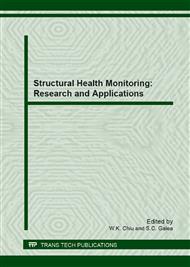p.445
p.456
p.465
p.477
p.489
p.501
p.510
p.522
p.534
Interaction of High Frequency Lamb Waves with Surface-Mount Sensor Adhesives
Abstract:
The application of Lamb waves to damage and/or defect detection in structures is typicallyconfined to lower frequencies in regimes where only the lower order modes propagate in order to simplifyinterpretation of the scattered wave-fields. Operation at higher frequencies offers the potentialto extend the sensitivity and diagnostic capability of this technique, however there are technical challengesassociated with the measurement and interpretation of this data. Recent work by the authorshas demonstrated the ability of fibre Bragg gratings (FBGs) to measure wave-fields at frequencies inexcess of 2 MHz [1]. However, when this work was extended to other thinner plate specimens it wasfound that at these higher frequencies, the cyanoacrylate adhesive (M-Bond 200) used to attach theFBG sensors to the plate was significantly affecting the propagation of the waves. Laser vibrometrywas used to characterise the wave-field in the region surrounding the adhesive and it was found that theself-adhesive retro-reflective tape applied to aid with this measurement was also affecting the wavefieldin the higher frequency regime. This paper reports on an experimental study into the influence ofboth of these materials on the propagating wave-field. Three different lengths of retro-reflective tapewere placed in the path of Lamb waves propagating in an aluminium plate and laser vibrometry wasused to measure the wave-field upstream and downstream of the tape for a range of different excitationfrequencies. The same experiment was conducted using small footprint cyanoacrylate film samplesof different thickness. The results show that both of these surface-mount materials attenuate, diffractand scatter the incoming waves as well as introducing a phase lag. The degree of influence of thesurface layer appears to be a function of its material properties, the frequency of the incoming waveand the thickness and footprint of the surface layer relative to the base material thickness. Althoughfurther work is required to characterise the relative influence of each of these variables, investigationsto date show that for the measurement of Lamb Waves on thin structures, careful considerationshould be given to the thickness and footprint of the adhesive layer and sensor, particularly in the highfrequency regime, so as to minimise their effect on the measurement.
Info:
Periodical:
Pages:
489-500
Citation:
Online since:
June 2013
Authors:
Price:
Сopyright:
© 2013 Trans Tech Publications Ltd. All Rights Reserved
Share:
Citation:


